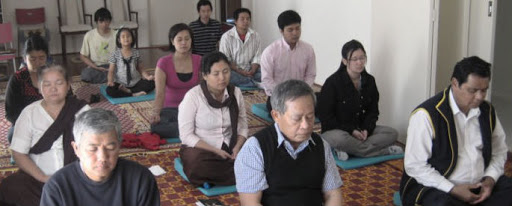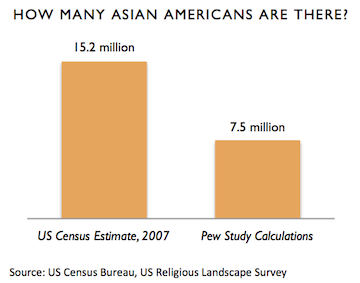
This month is Asian Pacific American Heritage Month, which I’ve decided to celebrate by asking a daily question on Twitter about Asian Buddhists in America.
If you tweet me an answer—even if it’s only an attempt—then I’ll post the answer on this blog. You’ll also get a postcard from me if you’re the first to answer correctly.
Last week, @onceinchbuddha responded to the following question:
The correct answer is 39%.
It’s important to provide some context, especially if you remember the report saying something different. When you read the Pew Forum’s “Asian Americans: A Mosaic of Faiths” report, you’ll quickly come across this statement: “A solid majority says they seldom or never meditate (60%).” This statistic is often repeated, such as in the Huffington Post, and so I’ve been concerned with the Pew Forum’s decision to lump together “seldom” and “never.”
The simple difference between my answer (39%) and the alternative (60%) is that I separate “seldom” and “never.” You can find these numbers buried in the appendix, where the survey questions are presented along with the proportions for each response. The question of interest here was: “How often do you meditate as a religious or spiritual exercise?” The following seven answer choices were given: several times a day, once a day, a few times a week, once a week, a few times a month, seldom, and never. The first five responses totaled 39%, while 21% responded “seldom” and 39% responded “never.” (One percent either chose not to respond or didn’t know.)
Those who responded “seldom” include all those who meditate some amount less than about 40 days a year. When we cite the statistic about Asian American Buddhists who “seldom or never meditate,” we’re effectively saying that someone who meditates, say, only on full-moon days is in the same group as someone who never meditates at all.
The Pew Forum’s choice on how to deal with “seldom” ultimately influences the popular narrative of how Asian Americans practice Buddhism. A key comparison is that there are as many Asian American Buddhists who say they never meditate (39%) as there are Asian American Buddhists who say they meditate “a few times a month” or more (39%). Depending on how you decide to group those who say they “seldom” meditate (21%), then either “a solid majority says they seldom or never meditate” or a solid majority says they meditate to some degree. The Pew Forum chose the former, which Ariana Huffington eventually interpreted to mean that Buddhist Asian Americans “place little emphasis on meditation.”
The best way to combat stereotypes about Asian American Buddhists is to listen to what we have to say. Sometimes that means digging into the details of an otherwise reputable study. If you want to learn more about Buddhist Asian America, then I encourage you to take a stab at answering one of my questions. I’m already learning a lot from the responses so far!
Photo credit: Panditarama Melbourne.





